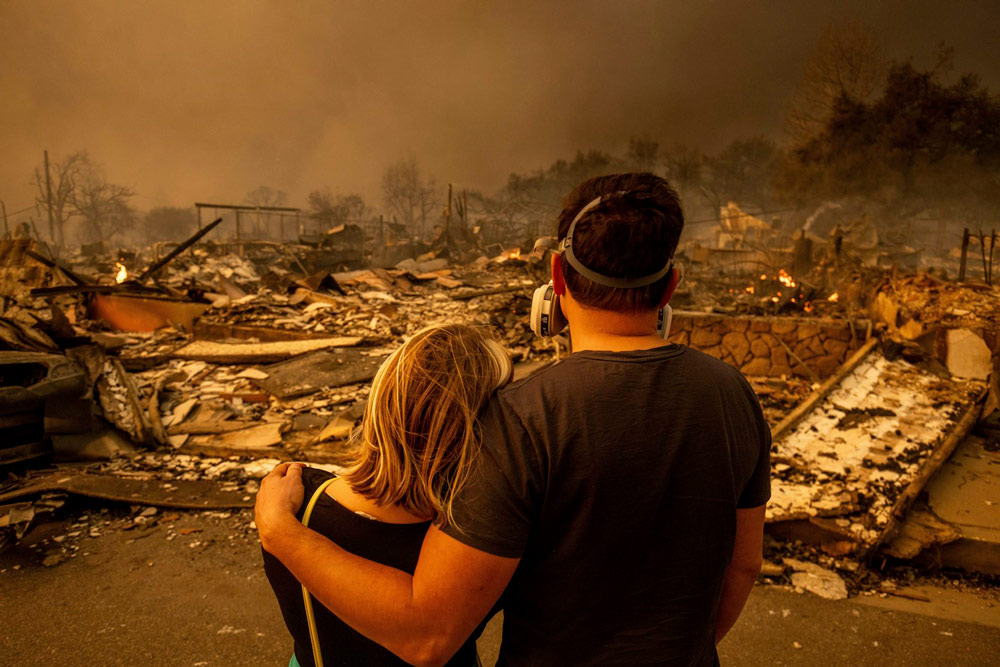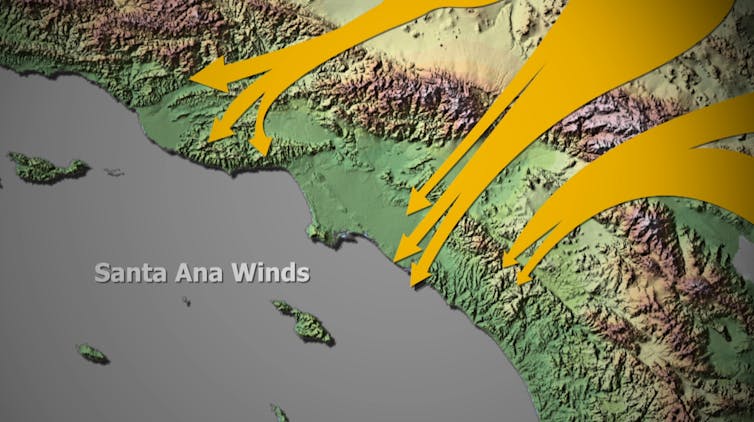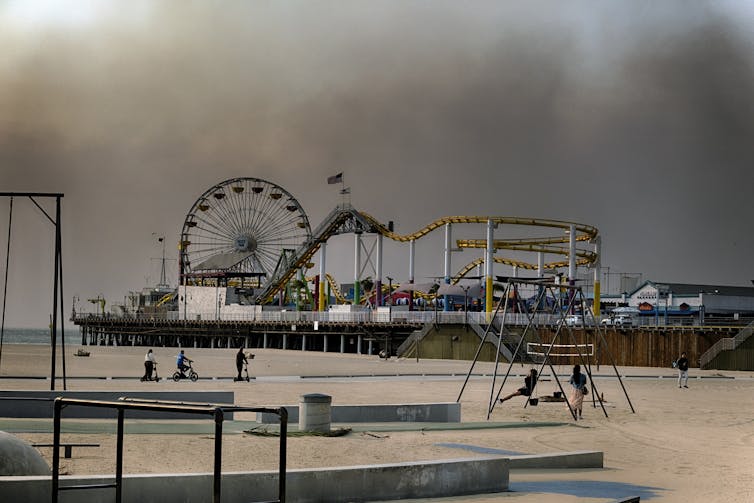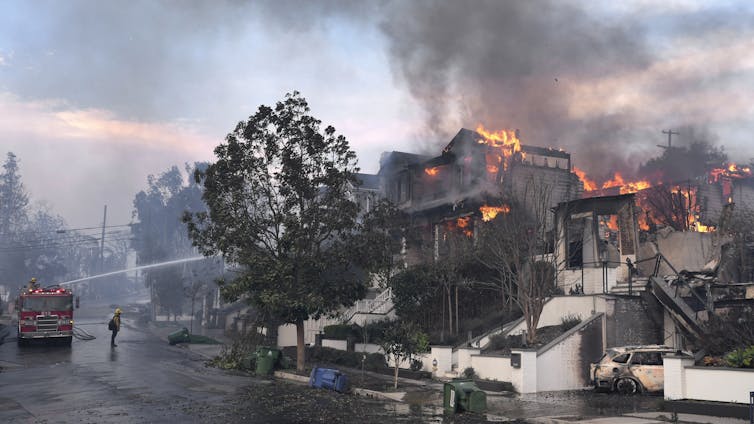
By Jon Keeley
Powerful Santa Ana winds, with gusts reaching hurricane strength, swept down the mountains outside Los Angeles and spread wildfires into several neighborhoods starting Jan. 7, 2025, creating a terrifying scene.
Thousands of homes and other structures, including several schools, had burned by Jan. 9, and at least five people had died. Officials urged more than 180,000 residents to evacuate at the height of the fires. With the winds so strong, there was little firefighters could do to control the flames.
Jon Keeley, a research ecologist in California with the U.S. Geological Survey and adjunct professor at UCLA, explains what causes extreme winds like this in Southern California, and why they create such a dangerous fire risk.
What causes the Santa Ana winds?
The Santa Ana winds are dry, powerful winds that blow down the mountains toward the Southern California coast. The region sees about 10 Santa Ana wind events a year on average, typically occurring from fall into January.
When conditions are dry, as they are right now, these winds can become a severe fire hazard.

USGS
The Santa Ana winds occur when there is high pressure to the east, in the Great Basin, and a low-pressure system off the coast. Air masses move from high pressure to low pressure, and the more extreme the difference in the pressure, the faster the winds blow.
Topography also plays a role.
As the winds rush downslope from the top of the San Gabriel Mountains, they become drier and hotter. That’s a function of the physics of air masses. By the time the winds get to the point where the Eaton Fire broke out in Altadena on Jan. 7, it’s not uncommon for them to have less than 5% relative humidity, meaning essentially no moisture at all.
Canyons also channel the winds. I used to live in the Altadena area, and we would get days during Santa Ana wind events when the wind wasn’t present at all where we lived, but, a few blocks away, the wind was extremely strong.
These strong, dry winds are often around 30 to 40 mph. But they can be stronger. The wind gusts in early January 2025 were reported to have exceeded 80 mph.
Why was the fire risk so high this time?
Typically, Southern California has enough rain by now that the vegetation is moist and doesn’t readily burn. A study a few years ago showed that autumn moisture reduces the risk of Santa Ana wind-driven fires.
This year, however, Southern California has very dry conditions, with very little moisture over the past several months. With these extreme winds, we have the perfect storm for severe fires.

AP Photo/Richard Vogel
It’s very hard to extinguish a fire under these conditions. The firefighters in the area will tell you, if there’s a Santa Ana wind-driven fire, they will evacuate people ahead of the fire front and control the edges – but when the wind is blowing like this, there’s very little chance of stopping it until the wind subsides.
Other states have seen similar fires driven by strong downslope winds. During the Chimney Tops 2 Fire in Tennessee in November 2016, strong downslope winds spread the flames into homes in Gatlinburg, killing 14 people and burning more than 2,500 homes. Boulder County, Colorado, lost about 1,000 homes when powerful winds coming down the mountains there spread the Marshall Fire in December 2021.
Have the Santa Ana winds changed over time?
Santa Ana wind events aren’t new, but we’re seeing them more often this time of year.
My colleagues and I recently published a paper comparing 71 years of Santa Ana wind events, starting in 1948. We found about the same amount of overall Santa Ana wind activity, but the timing is shifting from fewer events in September and more in December and January. Due to well-documented trends in climate change, it is tempting to ascribe this to global warming, but as yet there is no substantial evidence of this.
California is seeing more destructive fires than we saw in the past. That’s driven not just by changes in the climate and the winds, but also by population growth.
More people now live in and at the edges of wildland areas, and the power grid has expanded with them. That creates more opportunities for fires to start. In extreme weather, power lines face a higher risk of falling or being hit by tree branches and sparking a fire. The area burnt because of fires related to power lines has greatly expanded; today it is the major ignition source for destructive fires in Southern California.

AP Photo/Damian Dovarganes
The Eaton Fire, which has burned many homes, is at the upper perimeter of the San Gabriel Basin, at the base of the San Gabriel Mountains. Fifty years ago, fewer people lived there. Back then, some parts of the basin were surrounded by citrus orchards, and fires in the mountains would burn out in the orchards before reaching homes.
Today, there is no buffer between homes and the wildland. The point of ignition for the Eaton Fire appears to have been near or within one of those neighborhoods.
Homes are made of dried materials, and when the atmosphere is dry, they combust readily, allowing fires to spread quickly through neighborhoods and creating a great risk of destructive fires.
![]()
Jon Keeley is Research Ecologist at USGS and Adjunct Professor at the University of California, Los Angeles.




























Ed P says
It’s refreshing to see an article that doesn’t lay the wild fires at the door step of climate change. That excuse is sometimes used as a get out of jail card, or to do nothing.
I’m perplexed at how this much devastation is able to even happen with today’s technology and building codes. If earthquake resistant homes or hurricane resistant home are mandated, why not fire resistant? Local municipalities require upgrades during renovations for older properties in Florida, do they in California? Are the fire codes strong enough? We have Miami-Dade codes and even tougher in some areas of Flagler county.
Additionally, someone should have known that the water tanks could potentially run dry, that the reservoirs should have been filled especially during fire season, and better forest management was required. What about individual landscaping for yards? Will anyone admit it? The cover ones ass and lying, as well as finger pointing by the governing bodies is disturbing. The explanation that the winds prevented fixed wing or helicopter support is in fact true and would have reduced the stress on the fire hydrants but the wind conditions there are a fact of life.
It’s easy to criticize after the fact. However we are all going to pay the price when our homeowners insurance premiums rise because of this catastrophe. Additionally, FEMA’s role will also require a bigger budget.
Skibum says
Ed, I guess the reason you are so refreshed from not seeing any focus on the elephant in the room, climate change, mentioned in the article is probably because you are one of “those” who continue to disregard the mounds of actual scientific evidence that our planet is heating up year after year, making natural disasters such as fires, hurricanes and tornados much more unpredictable, more severe, and more deadly. If you need further evidence to persuade a change of mind, all you would have to do is listen to what the country’s major property insurers have been saying, and doing, because of their complete understanding of the problem facing them. State Farm, Allstate and other property insurers have notified the state of California that they are pulling out of the state and not renewing homeowner insurance policies specifically because of the extreme climate exacerbated wildfire danger that makes their corporate liability to billions of dollars in claims unsustainable. California’s last ditch insurance pool, similar to Florida’s Citizen’s Property Insurance Corp., is seeing an increase of more than 65% in new policies because of property insurance cancellations from private insurers. We saw the same thing here in FL, and the FL property insurers will tell you the same thing… their rates have increased not due to governmental malpractice or incompetence but because of the number and scope of natural disasters, in our case hurricanes, is getting WORSE! Remember last summer’s ocean water temperature near Key West? It reached a ridiculously high temperature of 101, which was unthinkable just a few years ago. That extremely warm water, as well as the very warm temps in the Gulf of Mexico, are what strengthens what would be less severe hurricanes into the monster Cat4 and Cat5 catastrophic natural disasters we have faced in increasing occurrences right here in our own back yard. So just STOP the misinformation and reliance on maga idiots that want to point fingers in every direction except the changing climate, because the truth is that major insurance companies already know and accept the truth that, somehow, you and others just simply refuse to acknowledge, probably for prurient political ideology.
Ed P says
Ski bum
And yet 5 days after the fires started, climate change has been repeatedly absolved from causing or exacerbating the catastrophe.
Experts are coming forward to say its was predicable and preventable. Urban sprawl, water mismanagement, forestry mismanagement not clearing brush and cutting in firebreaks, reduction of grazing from farm animals, infrastructure planning, building codes, lack of green spaces, landscaping and budgets cuts have all been referenced as the culprit. Decades and decades of mismanagement will be revealed as the problem.
So enlighten me, who says climate change? Once the anger sets in, the truth will be shouted by even the most liberal celebrities.
They will convict their own.
DaleL says
I remember from the Maui fires in Hawaii, that fire can get into homes through embers being blown into attic spaces through small gaps in the soffit area near the roof. Another way is for heat or wind blown debris to break a window. I’ve seen on the news that the wind speeds are as much as 100 mph. Hurricane force winds can damage homes or lift roofs just enough for the embers to get in. This is how homes built of concrete block with tile roofs can still catch fire. In Florida, hurricane force winds hit our homes with water and debris, not a barrage of debris and fire.
It comes down to the cost of construction versus fire risk. Building codes are tightened right after a disaster, only to be weakened years later when the cost is deemed too high.
I agree that the article was balanced as to the role of climate change.
Laurel says
Unbelievably sad! I can’t even imagine 😯. My heart goes out to the people there.
To make matters worse, certain politicians are blaming others for this disaster, for personal, political gains.
What this article brought up was excessive growth. Excessive growth is a strain on the environment as well as the community.
What it didn’t bring up is the resource of water. The lack of water is not so much the issue here, it’s the lack of water pressure. No municipality has the ability to provide water pressure under such circumstances. They are set up to address a couple of houses at a time, not every home owner turning on the spigot at the same time. The pressure goes down to nill.
Another factor, as stated here, are the winds. The winds gusted up to 100 mph, preventing helicopters from dropping water and retardants.
So, if you see a lot of finger pointing, consider the source.
JimboXYZ says
The growth hits home right here in Flagler County. There are too many other variables & factors to ignore for this level of failure & domestic terrorism. I can’t comprehend defensing the incompetence of State of California from Gavin Newsom to the mayors of individual townships in Los Angeles. That’s not politicizing anything really, it’s calling out leadership for failing. California Dems voted to enact legislation that would provide $ 150K for home purchases, for this ? Newsom even figured it out & vetoed that nonsense. His momentary enlightenment of common sense. As the media has reported a pair of arsonists have been detained & arrested for these fires. Unfortunate that the devastation & destruction happened, there is nothing anyone can do about that at this point. My empathy doesn’t extend to the criminal & incompetent. If there is a silver lining to these terrorist attacks s that Biden-Harris has 9 days remaining & it happened under their watch, Trump-Vance will inherit this man-made disaster. Santa Anna winds, Santa Ynez Valley reservoir being off line are just symptoms of the criminal arson that was heinously started when the weather conditions were ideal for rapid spread of a fire. This isn’t a natural disaster, my theories aren’t conspiracy theories, all of it is attributable for cause & effect for FACTS ! We are dealing with the human race here. A lot of good people infiltrated by bad ones. It doesn’t take much for the 99 good people to be wiped out by 1 bad one. This terrorist attack was perpetrated on the day when a simple online weather report would result in maximum possible property damage & casualties.
As for the 100 mph winds, that’s unsubstantiated claims, details indicate winds were +/-60 mph for rarer isolated gusts, never exceeded +/-30 mph on the 7th & 8th there. I would say the Santa Ana winds were a little worse than what we were getting thru-out the day here in FL for the same time period. That’s always the problem with the one’s that bend facts to make something worse than it actually was. I’m not discounting 20-33 mph sustained winds, 60+ mph rare gusts. but by the same token I’m not part of the group that failed Los Angeles trying to overreach and turn it into the storm of all storms. This is a perfect storm of conditions, enabled by human negligence & incompetence for a Governor that should’ve been removed years ago. They voted for Newsom, they deserve him. The one’s that put him on a ballot for recall don’t deserve Newsom’s brand of incompetence. then or now.
https://www.weather.gov/wrh/timeseries?site=CNIC1
Flagler county itself had higher winds on those days. 20-25 mph, we were getting our version of the Santa Anna winds FL style. Consider the source to me suggests that we are 2,000+ miles away safe. It’s surreal in that regard, really doesn’t effect us for having to look at it, smell the charred remains. But we are certainly going to feel the effects economically. This needs to end, empowering the incompetent government leadership that continually fails. It’s criminal how this ever even happened. And citizens need to finally stop walking around with our heads up our butts, acting like we’re too stupid to figure it out & know the difference. This is what happens when one condones 5 years of Biden-Harris maneuvering for a power grab & 4 years of inflation for getting nothing more than what you already had & were getting devoid of overpopulation.
Skibum says
You are completely bonkers if you are waiting for Trump to be a bastion of knowledge, reason and common sense! Remember when he not long ago occupied the WH and criticized CA Gov. Newsom after one of the extremely large and devastating wildfires in Northern CA? This idiot actually had the 1/2 brain cell rattling around in that vacuum between his ears to utter that had Newsom sent state employees into the forests with rakes to rake up all of the pine needles, then CA would not have suffered such a heavy death toll! Then it wasn’t long until he came up with another infamous brain fart during the pandemic, you remember? That wowzer was about using BLEACH to try to inject or wash away the covid virus! I’m sure experts in many fields are waiting with bated breath to see what winners the dysfunctional, delusionary drumpty trumpty will enamour us with this next round. And God forbid, we would ALL please, please ask your daddy NOT to pick up another sharpie and try to change a NOAA hurricane map EVER EVER AGAIN!!!
Skibum says
I was born and raised in L. A., living in the San Fernando Valley for the first 30 years of my life. The Santa Ana winds have always been both a blessing and a curse to Angelenos. Back in the 60s and 70s when L. A.’s infamous smog was much worse than now, the ocean breeze blowing inland from the Pacific Ocean would often send the worst of the smog into both the San Gabriel and San Fernando valleys, only to be trapped up against the surrounding hills, and smog alerts were common with advisories for those with respiratory problems to curtail outdoor activities. Both my twin brother and I had asthma, and many times we could not participate in physical education at school due to wheezing and difficulty breathing in the smoggy air. But during those times of the year when the Santa Ana winds would blow from the east, through the canyons and hills into the valley areas, all of the smog would be forced westward and out over the ocean, and we would have beautiful blue skies and clean air to breathe. But, of course, those winds were always hot winds, and usually in the fall when the dry conditions would spark wildfires. But the fire conditions back then were NOTHING like seen now, with more and more residential development encroaching into the hills and canyons where fire danger has always been significantly higher, and that has allowed really horrendous fires to spread from those areas into the city proper. L. A. and California’s increased danger and property insurance liability due to allowing development in to wildland areas is not unlike Florida’s penchant for allowing homes to be build right on the ocean’s edge when we have a significant threat of destructive hurricanes 6 months out of the year. Something has to change because the west’s wildfires, the historical “tornado alley” in the center of the country, and the hurricanes on the east coast have been getting increasingly worse and less predictable, and the seasons and areas that are vulnerable to these annual natural disasters are expanding. Climate scientists have been warning all of us about these increasing threats for some time now, but there are still those who would rather just close their eyes, bury their heads in the sand to reality, but then only after disaster strikes close to home, start complaining and pointing their fingers every which way trying the blame game but still not fully ready to name the real culprit and address the difficult AND expensive solutions that must be made and funded if we are to get through this ever expanding disaster to come.
JimboXYZ says
More empty calories from the Gavin Newsom Administration in California. A ban on insurance companies cancelling homeowners policies. Just look at the devastation, who in their right mind would pay another penny of insurance premium on this level of destruction ? Do they even have jobs to earn the premium policy money ? Closing the barn/corral gate after the livestock got away. The only thing that remains is for Oprah Winfrey to swoop in to buy land for pennies on the dollar, just like Hawaii.
https://www.realtor.com/news/real-estate-news/california-insurance-policy-ban-los-angeles-wildfires/
https://www.essence.com/news/money-career/oprah-real-estate-maui-hawaii-black-billionaire/
Gene E says
When your “governor” Newsom cuts $100 million for fire control and give $13,600 to the Homosexual Chorus group in L.A. along with other DEI organizations citizens of Cali are the unfortunate victims of Demos.
Sherry says
And now for some actual factual information about water resources in Southern California, this from the BBC:
BBC Verify looked into the facts behind the political fallout.
What has Trump claimed?
In a social media post on Saturday evening, Trump blamed California’s leaders for the current situation.
“The fires are still raging in LA. The incompetent pols have no idea how to put them out. Thousands of magnificent houses are gone, and many more will soon be lost,” he wrote on Truth Social.
“They just can’t put out the fires,” he added. “What’s wrong with them?”
Earlier in the week, he criticised Governor Newsom for refusing to sign the “water restoration declaration put before him that would have allowed millions of gallons of water” to put out the fires.
But the specific declaration he mentions doesn’t appear to exist. We’ve also searched for this document and been unable to find it.
Newsom has previously opposed efforts to redirect more water to southern California.
This includes a 2020 presidential memorandum in which Trump sought to divert water away from Northern California to farmland further south.
Newsom opposed this at the time, saying he wanted to protect “highly imperilled fish species close to extinction”.
That is what Trump is referencing in his post blaming Newsom for the response to the wildfires, where he says the governor “wanted to protect an essentially worthless fish”, Trump spokeswoman Karoline Leavitt has confirmed.
In an interview with Pod Save America on Saturday, Newsom said Trump’s statements were “made up” and “delusional”.
California’s attorney general ultimately blocked the measure to redirect water to the south, citing potential harm to endangered species and saying that it was not scientifically justified.
Jeffrey Mount, senior fellow at the Public Policy Institute of California’s Water Policy Center, said: “The federal government does not deliver water from northern California to southern California.
“While efforts to save Delta smelt, along with salmon and steelhead trout, do reduce the amount of water that is moved from northern California by the state at certain times, it has no bearing on the current availability of water for fire-fighting.”
Although southern California is currently experiencing a drought, data shows its reservoirs are almost all currently above the historic average for this time of the year. None are at significantly low levels.
However, one large reservoir in Pacific Palisades, the Santa Ynez Reservoir, was closed for maintenance and empty when the fire broke out.
Officials from the Los Angeles Department of Water and Power (DWP) said that if the Santa Ynez Reservoir had been operational, it might have increased the supply of water, but that it’s unclear what the ultimate effect might have been.